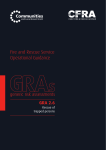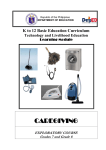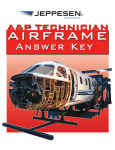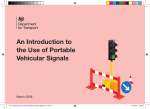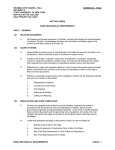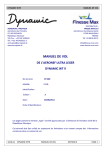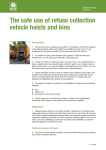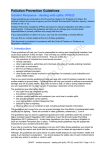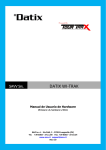Download Generic risk assessment 4.5: working with helicopters
Transcript
Fire and Rescue Service Operational Guidance GRA 4.5 Working with helicopters Generic Risk Assessment 4.5 Working with helicopters December 2010 London: TSO Published by TSO (The Stationery Office) and available from: Online www.tsoshop.co.uk Mail, Telephone, Fax & E-mail TSO PO Box 29, Norwich, NR3 1GN Telephone orders/General enquiries: 0870 600 5522 Fax orders: 0870 600 5533 E-mail: [email protected] Textphone: 0870 240 3701 TSO@Blackwell and other Accredited Agents Customers can also order publications from: TSO Ireland 16 Arthur Street, Belfast BT1 4GD Tel 028 9023 8451 Fax 028 9023 5401 Published with the permission of the Department for Communities and Local Government on behalf of Her Majesty’s Stationery Office. © Crown Copyright 2010 ISBN 978 0 11 754067 5 Copyright in the typographical arrangement and design rests with the Crown. This is a value added publication which falls outside the scope of the HMSO Class Licence. Applications for reproduction should be made to the Office of Public Sector Information, Information Policy Team, Kew, Richmond, Surrey, TW9 4DU. Printed in the United Kingdom by The Stationery Office J002382901 C2 12/12 6764 19585 The Generic Risk Assessments in this series only apply to England. Contents SECTION 1 GRA 4.5 Working with helicopters Scope 5 5 Significant hazards and risks 6 Moving rotor blade 7 Suspended loads 7 Downwash 8 Incorrect approach/boarding/disembarking 8 Noise 9 Accidental activation of aircraft safety systems 9 Manual handling 9 Conditions that may affect the use of helicopters 10 Aerials 10 Engine exhausts 10 Weapon systems 11 The presence of helicopters on scene not requested by FRSs 11 Disruption to/interference with FRS’ communication systems 11 Aviation Fuel 11 Falling from height/objects falling from height 11 Search/spot lights 11 Use of radios 11 Key control measures 12 Pre-planning 12 Training 12 Command and control 14 Safety Officers 14 Personal Protective Equipment 15 Moving rotor blades 16 Suspended loads 16 Downwash 16 Approach/boarding/disembarking 17 3 Noise 17 Accidental activation of aircraft safety systems 17 Manual handling 18 Landing 18 Life jackets 19 Other precautions 19 Post incident 19 Insurance 20 Falling from height/objects falling from height 20 SECTION 2 Summary of Generic Risk Assessment 4.5 4 21 SECTION 1 Generic risk assessment 4.5 Working with helicopters Scope This Generic Risk Assessment (GRA) examines the hazards, risks and control measures relating to incidents where Fire and Rescue Service (FRS) personnel are required to work at scenes where helicopters may be present. Unmanned aerial vehicles such as drones fall outside the scope of this document. The use of helicopters in emergency situations is becoming more common. A number of services provide this facility, including: • air ambulance services • Maritime and Coastguard Agency • military • Forestry Commission in rural areas • police services • private companies. Helicopters are often selected for use because of their ability to gain access to otherwise inaccessible areas, and/or their capability for rapid transportation over large distances. FRS’ operations, which may involve working with helicopters, include: • firefighting • scene overview and survey and reconnaissance • transportation of personnel and/or equipment • use of helicopter thermal imaging systems • search and rescue operations • medical evacuations • offshore incidents. Helicopters may also be deployed to the scene of FRS operations although not requested by the FRS, e.g. by the police or media. This may create additional risks to FRS personnel. Generic Risk Assessment 4.5 – Working with helicopters 5 Depending on the nature and scale of the operational incident, a variety of significant hazards may be present. FRSs may therefore need to consider the contents of other specific GRAs in this series. This GRA should therefore considered in conjunction with all other relevant GRAs, which may include: • GRA 3.4 Fighting fires in rural areas • GRA 4.3 Incidents involving transportation systems – Air. FRSs must conduct their own assessments and produce their own safe system of work (which includes Standard Operating Procedures (SOPs), training programmes, provision of equipment, levels of response etc.) within the context of integrated risk management plans, local conditions, knowledge and existing organisational arrangements. The primary responsibility for the helicopter and its crew will rest with the pilot and service providing the facility. The Fire and Rescue Service may not be in full control of operations or have the primary responsibility particularly where the Fire and Rescue Service is playing a minor role. Significant hazards and risks The hazards present when working with helicopters may involve one or more of the following: • moving rotor blades • suspended loads/static electricity • downwash • incorrect approach/boarding/disembarking • noise • accidental activation of aircraft safety systems • manual handling • conditions which may affect the use of helicopters (including landing) • aerials • engine exhaust • weapons systems • the presence of helicopters on scene not requested by the FRS • disruption to/interference with FRS’ communication systems • aviation fuel • falling from height/objects falling from height 6 Generic Risk Assessment 4.5 – Working with helicopters • search/spot lights • use of radios. Moving rotor blades Consideration should be given to the hazards presented by moving rotor blades. Stationary helicopters may have rotor blades still in motion (this may not be evident), creating hazards to personnel who are required to perform any or all of the following: • approaching the helicopter • boarding the helicopter • disembarking from the helicopter • working in or around the helicopter • transporting equipment to or from the helicopter • transporting casualties to or from the helicopter. Most helicopters have one large overhead rotor, coupled with a smaller stabilising rotor at the tail. The number of individual blades in each rotor varies from one design to another, but typically is between two and five. On some helicopters, as the rotors slow, the rotor blades will droop, causing the tips to become significantly lower than the height of the helicopter. Some helicopters utilise a fenestron or ducted tail rotor where the tail rotor has smaller rotor blades housed in a duct. Consideration should also be given to helicopters with no tail rotor. Personnel should treat these as they would a helicopter with a tail rotor, because of hot gases from the exhaust and the associated risk of injury. Suspended loads When working with a helicopter operating a suspended load (including water carriers), there are additional hazards to consider. Helicopters may use either slings or nets to transport equipment, or alternatively water ‘buckets’ or containers when ‘water bombing’ is required. The hazards of personnel receiving impact injuries from these suspended loads may be more likely when personnel and helicopters are required to work in close proximity. A further potential hazard associated with suspended loads is that of static electrical shock. In cases where a helicopter ground crew are not available, personnel may be required to load or unload equipment from under-slung slings or nets. Helicopters that carry loads will normally have an earthing line to discharge the static build up. FRS personnel therefore need to be aware that any load carried under a helicopter has the potential to cause harm through the build up of static electricity and the resultant potential difference. Any load jettisoned by the pilot will become hazardous to those working below. Generic Risk Assessment 4.5 – Working with helicopters 7 Downwash Helicopters fly because the rotors accelerate a mass of air downward that is at least equal to the mass of the aircraft. The vertical velocity of this column of air (or downwash) varies, dependant upon a number of factors, which include: • surface wind speed • main rotor radius • ‘disc loading’ (the weight of the helicopter divided by the ‘swept’ area of the rotor blades). Whenever helicopters take off, land or hover close to the surface, the downwash is deflected horizontally. Rotor downwash is invisible unless in conditions of smoke, dust, mist or foliage. However, deflection across the ground may be hazardous for up to 70 metres from the aircraft. Rotor downwash will create considerable ground disturbance, turning any items not secured into possible projectile hazards. Some other hazards created by rotor downwash include: • contaminants blown into eyes, open wounds, sterile dressings, etc. • dust/sand getting into the air intakes • possible re-ignition of dying fires or intensifying an established fire situation • spreading contaminants at chemical, radiological, biological and terrorist incidents • stirring up water, reducing sub-surface visibility • equipment or personnel being displaced or blown over • noise created by the turbulent movement of air • loose articles may be blown into rotors and possibly engine intakes, affecting flight capability. Incorrect approach/boarding/disembarking There may be occasions when FRS personnel are required to approach, board or disembark from stationary helicopters. The hazards arising from incorrect approach/boarding/disembarking to or from helicopters may be due to any or all of the following: • personnel approaching from the rear or side of the helicopter, where they cannot be observed by the pilot (Note – this is not a hazard with a Chinook aircraft as the standard operating procedure for a Chinook is to approach from the rear in full view of the aircrew loadmaster) 8 Generic Risk Assessment 4.5 – Working with helicopters • personnel approaching the ‘danger area’ i.e. the area immediately adjacent to the tail rotor • personnel approaching assuming an upright posture, or carrying equipment in an elevated position • personnel approaching or disembarking on the uphill side of a helicopter on sloping ground • personnel approaching with communications antenna raised • personnel coming into contact with hot exhaust ports • personnel approaching or disembarking during ‘engine shutdown’ procedures. Noise The noise created by the engines and to some extent the downwash of air creates additional hazards to personnel working with helicopters. Hazards posed by noise may be two fold: • if the noise is of such intensity that normal speech cannot be heard, personnel may mishear (or not hear) critical safety information and may expose themselves and/or others to additional hazards • prolonged intense noise may result in damage to hearing. Accidental activation of aircraft safety systems Helicopters are provided with safety systems, some of which may be automatic in operation. These include: • Water actuated flotation gear - found in wheel hubs or on sponsons (flotation devices to give stability on the water), braced to the fuselage by fixed struts, mounted on skids or located behind fuselage panels (Merlin). They are usually marked with a warning sign. • Automatically deployable emergency locator transmitters (ADELT) – the ADELT unit is attached to the fuselage on the opposite side of the tail cone from the tail rotor. Accidental activation of any type of vehicle safety system may create hazards to personnel, as release mechanisms, or parts of the vehicle, for example, wheel hubs, may be ejected prior to activation. Manual handling Loading equipment or casualties onto and off a helicopter may increase the risk of manual handling injuries due to restricted space or access and egress. Poor posture necessitated by having to crouch when approach the helicopter will add to the manual handling risk. Unstable terrain and uneven ground will make carrying casualties and equipment difficult, adding to the risk of manual handling injuries. Generic Risk Assessment 4.5 – Working with helicopters 9 Conditions that may affect the use of helicopters There may be incidents where, although advantageous to work with helicopters, the conditions on the incident ground may affect their safe use. Examples of such conditions include: OVERHEAD POWER LINES, TREES AND OTHER HAZARDS Landing sites and flight paths are required to be completely free from any form of overhead entanglement. If any hazards are present, the pilot should be informed of them prior to flight. ENVIRONMENTAL CONDITIONS High wind and/or inclement weather conditions may create additional hazards, especially during helicopter landings and take-offs, therefore greater safety distances may be necessary. Hazards may be compounded due to poor visibility or darkness. SMOKE The amount of smoke produced, the density of the smoke, and the height of the smoke plume or cloud, are all factors that may affect the safe use of helicopters. SLOPING GROUND AND OTHER LANDING FACTORS Sloping ground is hazardous for helicopters and is not suitable for use as a landing area. Sandy, dusty or soft ground should be avoided. LANDING SITES Where pre-determined landing sites are not available, landing sites such as fields or road carriageways may be considered although it should be noted that these may pose additional hazards such as unsuitable ground, loose debris, and contact with animals or collision with vehicles. The use of vehicle headlights and handheld torches to illuminate a landing sight will cause considerable problems for the pilot if shone directly at the helicopter as the pilot may have night vision goggles on. Aerials Aerials, particularly high frequency aerials which are cables slung down the side of the aircraft, pose a significant hazard during high frequency transmissions and can cause burns. Engine exhausts The height of the exhaust depends on aircraft type, but personnel should be aware that they exist and should expect a warm or hot blast of air when manoeuvring near the aircraft. Personnel must keep clear of all helicopter tail sections even if they have no tail rotor due to the hot exhaust. 10 Generic Risk Assessment 4.5 – Working with helicopters Weapons systems Military helicopters may have weapons systems on board, which create additional hazards. The presence of helicopters on scene not requested by FRSs On occasions, helicopters have turned up on scene without a request from a FRS e.g. media helicopter, police helicopter. This can create issues e.g. fanning flames, changing the direction and intensity of a fire,affecting communication systems and, in particular, the downwash disturbing water reducing sub-surface visibility and affecting search operations. Disruption to/interference with FRS’ communication systems The use of helicopters may cause disruption to or interference with FRS’ communication systems. Aviation fuel Helicopters contain aviation fuel and, as such, this poses a risk should there be an incident involving the helicopter. Falling from height/objects falling from height There is a risk of falling from height when embarking/disembarking a helicopter and being transported in a helicopter. There is a risk of objects falling from height if unsecured. Search/spot lights Search/spot lights are fitted to some police/military helicopters. They provide illumination over a wide area and are useful during search and rescue operations. These lights can be extremely powerful and personnel should avoid looking directly into them. Use of radios With reference to using fire ground radios on board a helicopter or close to a helicopter, there should be no interference as most helicopter’s electrical/electronic equipment is protected from the electromagnetic field that is generated by the engine. If there was a problem or interference detected, the pilot would ask for the radios to be turned off. Generic Risk Assessment 4.5 – Working with helicopters 11 Key control measures Pre-planning Pre-planning is key to enhancing the safety of firefighters and others likely to be affected by FRS’ operations. The Integrated Risk Management Plan of each FRS will set standards and identify the resources required to ensure safe systems of work are maintained. Each FRS should assess the hazards and risks in their area relating to this Generic Risk Assessment and site-specific plans (e.g. pre-determined landing sites) should be considered for locations where these are significant. This assessment should include other FRS’ areas where ‘cross border’ arrangements make this appropriate. Such contingency plans should include: • levels of response • relevant standard operating procedures • tactical considerations, including rendezvous points (RVPs), appliance marshalling areas and access points. Pre-planning is underpinned by information gathering, much of which will be gained through inspections or visits by FRS staff – for example, those covered by section 7(2)d of the Fire and Rescue Services Act 2004. Information should also be gathered and used to review safe systems of work, etc. from sources both within and outside the FRS, including: • military • fire safety audits • incident de-briefs • health and safety events • local authorities • local resilience fora. Involving others in pre-planning is also an effective way to build good working relations with partner agencies and other interested parties, such as site owners. FRSs should ensure systems are in place to record and regularly review risk information and ensure that new risks are identified and recorded as soon as practicable. FRSs must ensure that the information gathered is treated as confidential, unless disclosure is made in the course of duty or is required for legal reasons. FRSs should consider the benefits of using consistent systems and formats to record information from all sources. Consideration should also be given to how timely access will be provided to information to support operational decision making. 12 Generic Risk Assessment 4.5 – Working with helicopters Information needs and the capacity of FRS staff to assimilate information will vary, in proportion to the nature and size of incident and what stage the operational response has reached, so arrangements need to be flexible and may be based on more than one system. Specific pre-planning for this generic risk assessment should include: • identification of pre-determined landing points • liaison with other agencies to determine protocols and procedures for the FRS use of helicopters • liaison with other agencies including the media to establish protocols and procedures on the use of helicopters that may affect FRS operations at the incident • consideration given to FRS’ communication systems and the possible disruption or interference to these from the use of helicopters. Training When formulating a training strategy FRSs should consider the following points: • FRSs must ensure their personnel are adequately trained to deal with thehazards and risks associated with working with helicopters • The level and nature of training undertaken should be shaped by the informed assessment of operational and individual needs in accordance with the FRS’ guidance on the integrated personal development system, national occupational standards and any internal training plan. Training needs should take account of those more likely to come into contact or work with helicopters (such as specialist firefighting and rescue teams and FRSs with formal arrangements for the use of helicopters) and those whose contact with helicopters may be occasional (such as fire crews attending a road traffic collision) • Training and development should follow the principles set out in national guidance documents. • Training and development programmes should generally be structured so that they move from simple to more complex tasks and from lower to higher levels of risk • Training and development will typically cover standard operational procedures as well as ensuring knowledge and understanding of equipment and the associated skills that will be required to use it • Training and development programmes should consider the need for appropriate levels of assessment and provide for continuous professional development to ensure maintenance of skills and to update personnel whenever there are changes to procedure, equipment, etc. Generic Risk Assessment 4.5 – Working with helicopters 13 Training outcomes should be evaluated to ensure that the training provided is effective, current and it meets defined operational needs as determined by the FRS Integrated Risk Management Plan. Command and control The Incident Commander should adhere to the principles of the current national incident command system. Prior to committing personnel to any hazard area the Incident Commander must take account of the actual information about the incident that is available to make operational decisions in what are recognised as sometimes dangerous, fast moving and emotionally charged environments. A thorough safety brief prior to deployment of personnel within the hazard zone should be carried out. There are numerous safety issues to be borne in mind whenever FRS personnel are required to work with helicopters. Incident Commanders will need to ensure strict control of the incident ground, and ensure that all personnel are continually supervised and briefed of the dangers. It is highlighted that the primary responsibility for the helicopter and its crew will rest with the pilot and service providing the facility. The FRS may not be in full control of operations or have the primary responsibility particularly where the FRS is playing a minor role. Co-ordinated Command and Control between the FRS and other organisations should be established at an early stage. This will always include the helicopter crew, but may also include police, health services and/or national park wardens. Training and familiarisation with protocols will also need to be conducted and maintained. Where a helicopter is on site and affecting fire service operations, the Incident Commander will need to ensure liaison with the appropriate service or organisation so that safe systems of work can be implemented. The Incident Commander will be responsible for the safety of FRS personnel who are operating within the vicinity of helicopter operations and the pilot will be responsible for the safety of the helicopter and those on board. Safety Officers The early appointment of one or more Safety Officers will help ensure that risks are either eliminated or reduced to an acceptable level. A safety decision-making model should be used to brief Safety Officers regarding the nature of the incident, the allocated task and prevailing hazards and risks. The Incident Commander should confirm that the Safety Officer understands: • their role and area of responsibility • allocated tasks • lines of communication. 14 Generic Risk Assessment 4.5 – Working with helicopters Those undertaking the Safety Officer role should: • be competent to perform the role • ensure personnel are wearing appropriate personal protective equipment • monitor the physical condition of personnel and/or general or specific safety conditions at the incident, in accordance with their brief • take any corrective action required to ensure safety of personnel • update the Incident Commander or senior Safety Officer regarding any change in circumstances • not be engaged in any other aspect of operations, unless this is required to deal with a risk critical situation. The role of a Safety Officer can be carried out by any of the FRS roles, but the complexity of the task, size of the incident and scope of responsibility should be considered when determining the supervisory level required. Safety Officers should wear nationally recognised identification to indicate they are undertaking the Safety Officer role. FRSs should ensure that training and other measures (such as aide-memoires) are in place and available to support those staff liable to undertake this role. Personal Protective Equipment FRSs must ensure that any personal protective equipment provided is fit for purpose and meets all required safety standards. When choosing suitable protective garments, the standard of clothing worn beneath the specialist personal protective equipment should also be taken into account. Consideration should also be given to the selection of suitable sizes and gender requirements of personal protective equipment. Personal protective equipment should also take account of the need for rescuers to be visible against the operational background including night working and for the Incident Commander and other managerial and functional roles (defined in the national incident command system) to be distinguishable. All personnel must use appropriate levels of service provided personal protective equipment and respiratory protective equipment as determined by the safe system of work. Although there is no requirement to wear high visibility clothing unless operating from an aircraft that requires it, FRS personnel working in the vicinity of a helicopter are advised to wear high visibility clothing where possible. A pilot should not normally hover more than 60 feet from a person but high visibility clothing is advisable as the pilot would ordinarily be able to see people from the air a lot easier than if none was to be worn. The colour for most airfields is green but orange should be just as suitable on most occasions. When rotors are turning, or engines running, ear and eye protection will also be necessary. Generic Risk Assessment 4.5 – Working with helicopters 15 Moving rotor blades • If FRS personnel are required to travel in a helicopter, they will be briefed by a member of the air crew before getting in or out on the correct method and safety precautions • All personnel, members of the public and animals must be kept clear of the helicopter during landing and take off • Personnel should not approach until indicated to do so by the pilot or helicopter crew • Personnel must approach or leave the helicopter in a crouched position and always on the downhill side of sloping ground. A sudden wind gust can cause the rotor blades to dip to a level, which can result in serious injury or death • Personnel must not approach the helicopter from the rear, or walk near to the tail of the helicopter even if the helicopter has no tail rotor (blind spot for pilot) (Note – this is not a hazard with a Chinook aircraft as the standard operating procedure for a Chinook is to approach from the rear in full view of the aircrew loadmaster) • Keep in sight of the pilot, or a crew member • Never feel your way towards or away from the helicopter • If blinded by debris, personnel must stop and wait for assistance • Personnel must adhere to the instructions of the helicopter crew at all times when working in the vicinity of a helicopter • Never carry anything above head height (Intravenous drips, communications antenna, etc.) when approaching or leaving the helicopter. Suspended loads • all members of the public and non-essential personnel should be kept well clear from any landing sites or areas where ‘water bombing’ may be in use • the air crew will ensure that any loads to be moved are safely packaged and secured • personnel should not be permitted to ride in the helicopter whilst loads are suspended, including water bombing • when the bucket or container is being manually filled, or used to replenish appliance tanks, only the minimum number of personnel should be used to do this. Downwash • Fire helmets may be worn providing the chinstrap is fastened and the visor is down. Unsuitable helmets or headgear that cannot be secured with a chinstrap should be securely carried and not worn as they may be blown off the wearer’s head due to the downdraft 16 Generic Risk Assessment 4.5 – Working with helicopters • Personnel should protect their eyes from dust and debris if working near the downwash • All loose articles of clothing and equipment must be secured prior to entry or exit from a helicopter, due to the dangers of ingestion into the engines or blades, or the possibility of them becoming dangerous projectiles • Be aware of the possibility of fires re-igniting or established fires intensifying due to the fan effect of rotors. Have extinguishing media ready • Protect casualties from dust and debris using available personal protective equipment • All equipment for loading onto the helicopter should be secured and weighted down where necessary. Approach/boarding/disembarking • personnel must adhere to the instructions of the helicopter crew at all times • personnel must not approach from the side or rear of the helicopter where they cannot be observed by the pilot • personnel must not approach the danger area immediately adjacent to the tail rotor • personnel must approach the helicopter adopting a crouched or bent posture • personnel must not approach or disembark on the uphill side of a helicopter on sloping ground • the aircrew will secure any doors and hatches, as they are fragile and damaging them could mean the helicopter is unable to fly • whenever personnel are required to ride in a helicopter, seat belts and/or harnesses must be worn at all times they are available • smoking in, on or near helicopters is prohibited at all times. Noise • all passengers, including patients, should, where possible, wear appropriate hearing protection at all times when in proximity to the helicopter • ensure tasks are understood in advance to reduce the need to discuss issues in close proximity to the helicopter • personnel must be aware of the effect noise can have on animals. If possible forewarn animal owners and have the animals moved further away by those responsible for them. Accidental activation of aircraft safety systems • follow the instructions of aircrew at all times • mobile phones and pagers etc. should be turned off • adhere to warning signs. Generic Risk Assessment 4.5 – Working with helicopters 17 Manual handling • Try to get the helicopter as near as practically possible to the incident site. This will minimise the distance casualty/equipment needs to be carried • Use mechanical means to transport the casualty/equipment if possible/ practical. The incident site may be some distance from the nearest road. Utilise appropriate vehicles • Employ team-lifting techniques • Follow the instructions of aircrew if assisting with the loading of casualties or equipment in to the helicopter. Responsibility for the securing must rest with the aircrew. Landing • A suitable exclusion zone should be set up around the landing site with only essential personnel working within the zone • The pilot is responsible for where the aircraft lands. If the landing site selected is not suitable, (due to unsuitable geography, environmental conditions, such as wind or inclement weather, trees, aerials, soft ground, smoke plumes, etc.) or if the pilot observes a more appropriate landing site, the pilot may set the aircraft down elsewhere • Communications will need to be established between the pilot and the Incident Commander as soon as the aircraft arrives, and a plan of action agreed. The ultimate responsibility for the safety of the helicopter rests with the pilot, who will have the final decision on any issues regarding the aircraft • Landing sites will be chosen by the pilot. Unless suitably qualified or informed, it would be unwise for FRS personnel to advise on landing sites as a number of factors can affect safety. They can advise the pilot on ground conditions. When selecting landing sites, a site with a suitable, unobstructed run in approach will be chosen where possible. Helicopters will struggle to land vertically from a great height into a small area. It should be clear of trees and overhead cables. The area should be level and firm. The identified landing site should be inspected for any loose debris or items that can cause the helicopter harm, these should be cleared. Foreign object damage should be in the mind of all commanders. The controlling officer and any other FRS personnel near to the site should be clearly identifiable and must wear high visibility clothing, together with adequate ear and eye protection • Do not mark out a landing area for the helicopter with traffic cones or other items of equipment as such items can be lifted or moved by the rotor down-draught creating a flying object debris hazard • Responsibility to land on a road lies with the police. Where a landing is made on a road, the police must first secure it 18 Generic Risk Assessment 4.5 – Working with helicopters • Minimum time to be spent on the road by the helicopter (enough to fulfil its emergency function). On a motorway, dual carriageway or two-way road, when the helicopter is landing or taking off, the unaffected carriageway should also be closed at all times by the police/highways agency • Consideration should be given to securing the perimeter of the landing site prior to landing and taking off if possible. A helicopter landing usually attracts crowds including children. Close liaison with the police to achieve this would be beneficial • Never shine a torch at a pilot due to the use of night vision goggles. This will result in the pilot being temporarily blinded. Never direct vehicle lights or portable lighting towards a landing site. Life jackets Only manually operated life jackets should be used in flight. This is to prevent inflation inside the cabin if the helicopter ditches in water. There is a risk with automatic activation that personnel may forget to disable the jacket. Other precautions Personnel must keep clear of engine exhausts and aerials. Although it is unlikely in the UK, military helicopters may have weapons and/or pyrotechnic systems on board. FRS personnel must follow the guidance of the aircrew should this be the case. Avoid looking directly at search or spot lights. Post incident The following measures should be considered to help eliminate or remove risks after an incident, as appropriate to the nature and scale of the incident: • Any safety events; personal injuries, exposure to hazardous substances or near-misses should be recorded, investigated and reported in line with legislative requirements such as Reporting of Injuries, Diseases and Dangerous Occurrences Regulations 1995, etc. • Arrangements should be in place to either remove all contamination from personal protective equipment or to ensure safe and appropriate disposal and to check that it maintains agreed levels of integrity and protection for the wearer throughout its life cycle • As appropriate, occupational health support and surveillance follow up • Conduct a de-brief to identify and record any ‘lessons learned’ from the incident. De-briefs will range in complexity and formality, proportionate to the scale of the incident and in line with individual FRS’ procedures Generic Risk Assessment 4.5 – Working with helicopters 19 • Consider any changes required to safe systems of work, appliances or equipment in the light of any lessons learned from de-briefs or from safety events. The air crew should be invited to take part in a de-brief session • Consider the need to review existing information held on a premises or location, or the need to add a new premises or location into future preplanning, e.g. by adding to visit or inspection programme • Staff should be supported and monitored to identify whether they are experiencing any adverse affects and to check whether they would benefit from accessing counselling and support services • Consideration should be given to arranging for staff to make a contemporaneous written record of their actions. This information may be used to assist in any internal or external investigations or enquiries that follow any incident, e.g. coroners court, public enquiry, etc. Insurance Although not a control measure, it is important that FRSs ensure that they have insurance cover for working with helicopters, and that any service provider has adequate cover for FRS staff. Falling from height/objects falling from height If FRS personnel travel in a helicopter they will wear a seat belt or other suitable restraining device and embark/disembark under the supervision of the air crew or pilot. The air crew will be responsible for securing loads. Technical references 1 Manual of Firemanship part 6b: Practical Firemanship II 2 Manual of Firemanship part 4: Incidents Involving Aircraft, Shipping and Railways 3 Fire and Rescue Service Operational Guidance, Aircraft Incidents 4 Fire Service Manual Volume 2: Incident Command 5 Dynamic Management of risk at operational incidents, A Fire Service guide 20 Generic Risk Assessment 4.5 – Working with helicopters Generic Risk Assessment 4.5 – Working with helicopters 21 4 3 2 Approaching helicopter 1 Working near helicopter Working near helicopter Approaching helicopter Working in helicopter Working near helicopter Approaching helicopter Working near helicopter Activity Ref. No. Serious injury Risk Downwash (effects on fire) Downwash (effects on person) Re-ignition of fire Death, serious injury Noise, impaired hearing/ Hearing damage communication Poor decision making Slip and trip hazards, uneven ground Hazard Task – Initial stages of the incident/as the incident develops Working with helicopters Summary of Generic Risk Assessment 4.5 Section 2 Other agencies Members of the public FRS personnel Other agencies Members of the public FRS personnel Other agencies Members of the public FRS personnel Other agencies Members of the public FRS personnel Persons at risk Risk assessment. Appoint safety officer, Identify an appropriate landing area, brief crews, standby with extinguishing media, monitor. Incident Command System, maintain safe distance, establish and control inner cordon, use police to control an outer cordon if necessary, minimum crew in area, use shelter/protection if available, keep low, personal protective equipment. Secure clothing and equipment. Maintain appropriate distance, especially during landing and take-off (when ground based), Hearing protection. Ensure tasks understood in advance. Appoint safety officer, Incident Command System establish and manage inner cordon, illumination as required, minimum personnel, brief crews. Control measures 22 Generic Risk Assessment 4.5 – Working with helicopters 7 6 Approaching helicopter 5 Static electricity Working near helicopter Working near helicopter Collision with surrounding objects/ structures Suspended loads Approaching helicopter Risk Death, serious injury Death, serious injury Downwash (effects of Death, serious injury debris, projectiles, loose clothing and equipment Hazard Approaching helicopter Working near helicopter Activity Ref. No. Task – Initial stages of the incident/as the incident develops Working with helicopters Summary of Generic Risk Assessment 4.5 Other agencies Members of the public FRS personnel Other agencies Members of the public FRS personnel Other agencies Members of the public FRS personnel Persons at risk Incident Command System, establish ground to air communication, identify appropriate landing area, establish wind direction, and illuminate area as necessary. Appoint Safety Officer, Incident Command System, establish and control inner cordon, personal protective equipment, hi-visibility clothing, maintain distance, minimum crew, appropriate landing area, brief crews, secure loads. Incident Command System, Personal Protective Equipment, select most appropriate landing area, remove debris if necessary, secure equipment, establish and control inner cordon, use police to control an outer cordon if necessary, brief crew. Secure storage of equipment. Control measures Generic Risk Assessment 4.5 – Working with helicopters 23 9 Approaching helicopter 8 Working near helicopter Approaching helicopter Working near helicopter Working in helicopter Activity Ref. No. Effect of helicopter on animals such as livestock or pets Inclines and embankments etc. must be taken into consideration as headroom can be reduced. This can also be the case when rotors slow Impact by rotor blades on personnel (especially tail rotor) Hazard Death, serious injury FRS personnel Death, serious injury Other agencies Members of the public FRS personnel Other agencies Members of the public Persons at risk Risk Task – Initial stages of the incident/as the incident develops Working with helicopters Summary of Generic Risk Assessment 4.5 Personal protective equipment. Inner and outer cordon Incident Command System Work with owners to try to remove livestock and pets from area Training, appoint Safety Officer, Incident Command System, establish and control inner cordon, use police to control an outer cordon if necessary, minimum crew to approach helicopter, hi-vis clothing, maintain safe distance, do not approach rear of helicopter, follow helicopter crew instructions, keep in sight of the pilot, crouch, brief crew. Control measures 24 Generic Risk Assessment 4.5 – Working with helicopters 11 Approaching helicopter 10 Working near helicopter Approaching helicopter Working in helicopter Activity Ref. No. Risk Manual handling (ADELT) or lifejackets Manual handling injury Activation of safety Serious injury devices, such as floatation devices, “sponsons” (airbags), automatically deployable emergency locator transmitters Hazard Task – Initial stages of the incident/as the incident develops Working with helicopters Summary of Generic Risk Assessment 4.5 Other agencies Members of the public FRS personnel Other agencies Members of the public FRS personnel Persons at risk Follow the instructions of aircrew if assisting with the loading of casualties or equipment in to the helicopter. Responsibility for the securing must rest with the aircrew. Employ team-lifting techniques Use mechanical means to transport casualty/ equipment if possible/practical Minimise distance of carry where possible Use manual life jackets. Adhere to warning signs Mobile phones and pagers etc. should be turned off Follow the instructions of aircrew at all times Control measures Generic Risk Assessment 4.5 – Working with helicopters 25 Approaching helicopter Approaching helicopter Working near helicopter Working in helicopter 14 15 16 –c hange in ground conditions Working near helicopter 13 – reduced visibility Working in helicopter Falls from height Falling objects Incorrect boarding/ disembarking from helicopter Inhalation of exhaust fumes/heat – hypothermia – wind Inclement weather:– Approaching helicopter 12 Hazard Activity Ref. No. Members of the public Serious injury Other agencies FRS personnel Other agencies Members of the public FRS personnel Other agencies Members of the public FRS personnel Other agencies Members of the public FRS personnel Other agencies Members of the public FRS personnel Persons at risk Death Death, serious injury Death, serious injury Injury Death, serious injury Risk Task – Initial stages of the incident/as the incident develops Working with helicopters Summary of Generic Risk Assessment 4.5 Wear safety belt. Follow instructions of air crew when embarking, disembarking Familiarisation and training, equipment selection, ensure equipment secure to prevent movement, follow helicopter crew instruction. Incident Command System, establish ground to air communication, identify appropriate landing area, establish wind direction, and illuminate area as necessary. Avoid exhaust, establish and control inner cordon, brief crews, adhere to warning signs, monitor for compliance, Incident Command System. Risk assessment. Incident Command System, appoint safety officer minimum crew exposed to elements, personal protective equipment, high-visabilty clothing, use chemical meteorology (CHEMET) to help plan ahead if necessary, and consider welfare facilities, brief crews. Reconsider use of helicopter. Control measures 26 Generic Risk Assessment 4.5 – Working with helicopters 18 Approaching helicopter 17 Approaching, working near or working in military helicopters Working near helicopter Activity Ref. No. Live weapons systems. Live ordnance Use of search/spot lights Hazard Members of the public Serious injury Other agencies FRS personnel Other agencies Members of the public FRS personnel Persons at risk Death Temporarily impaired vision Risk Task – Initial stages of the incident/as the incident develops Working with helicopters Summary of Generic Risk Assessment 4.5 Liaison, training, use of liaison officers/police to gain information, maintain safe distance. Follow guidance of air crew. Warn others of the hazard if they are working in the affected area. Avoid looking directly at the light Control measures



























